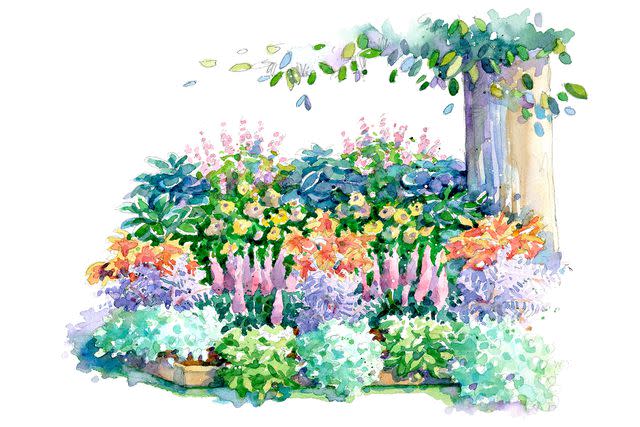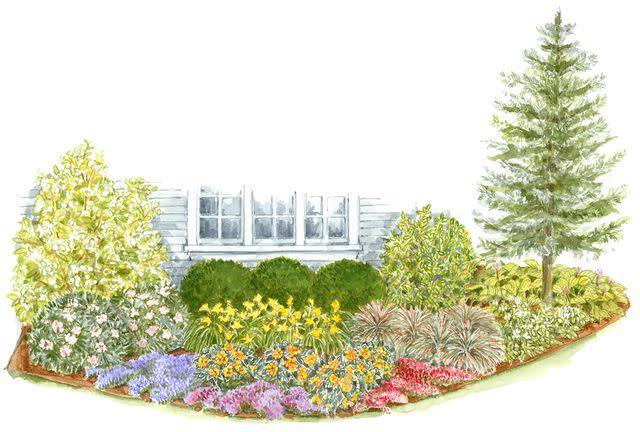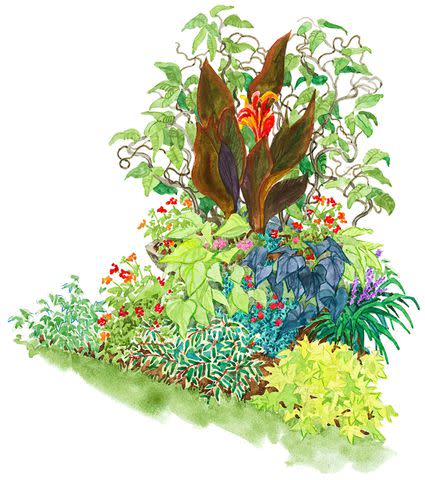How to Plant and Grow Deadnettle
Shade gardens can offer some tricky planting situations that just a few plants adapt to well. Deadnettle is one of the plants that thrives in shade and a wide variety of other growing conditions. The plant is easy to grow and brings lots of visual interest to a shady corner with a carpet of colorful foliage and long-blooming flowers.
The most basic varieties of deadnettles offer a dull grey-green foliage, but also have silver leaves or silver markings. There are a few varieties with golden foliage. Like many plants in the mint family, the small tubular blooms end in two lower lips and a large hooded top in shades of pink, purple and white. While their peak bloom is often in late spring to early summer, many varieties continue to put on blossoms throughout the growing season, only stopping when the first frost occurs.
Where to Plant Deadnettles
As members of the mint family, deadnettles share the characteristics those plants are known for: vigorous growth, toughness. and low maintenance. Deadnettles prefer shade where they take on a green hue and their attractive variegations fade a bit over time. These easy-to-grow plants require very little care once established and create stunning mats of color in a shade garden. Deadnettles are most at home in well-drained soil with even moisture. Once established, they are quite tolerant of dry soil; they may just be a bit less vigorous. The biggest concern is overly moist soil. Most species and varieties will not tolerate too much moisture, so be sure to avoid soggy soil, especially standing water.
Plant deadnettles wherever you want a dense, flowering groundcover that performs without a lot of fuss. Pair it with large-leaved plants to provide textural contrast in garden borders. It's a cottage garden favorite, looks good under shrubs and trees, and lines walkways nicely. It will even scramble around a rock garden as long as it's shaded.
Warning
Some types of deadnettle are invasive, depending on your location. Before planting, check with your local extension service for information about which species may be problematic in your region.
How and When to Plant Deadnettle
Deadnettle can be set out in the spring or the fall. If you live in an area with harsh winters, opt for a spring planting so that plants have a chance to develop a strong root system before the first freeze.
To plant nursery specimens, dig a hole twice as wide and as deep as the nursery pot. Remove the plant from the pot, tease the roots a little to loosen them and place the plant in the hole. You can amend the soil with a bit of compost before backfilling into the hole. Tamp the soil around the plant and water well to remove any air pockets.
Spacing requirements will differ depending on species and variety. Consult the plant tag or seed packet for correct spacing information.
Deadnettle Care Tips
Light
Most varieties of deadnettle prefer partial shade to shady conditions. In the cooler northern climates, some species can tolerate full sun.
Soil and Water
Average, well-draining soil is all deadnettle needs to thrive, although it prefers an acidic pH and a loamy soil texture. It will tolerate dry conditions well, which is why it's such a champ growing underneath shade trees. Don't site this plant in an area with consistently wet soil.
Give the plant about an inch of water each week, through rainfall or irrigation, to keep it growing, especially during its first year. Do not overwater.
Temperature and Humidity
Deadnettle is tolerant of dry conditions but its growth will slow as temperatures and humidity rise. Depending on variety, deadnettle may be evergreen in warmer climates. In the colder north, the plant is herbaceous and benefits from a covering of mulch in subzero temperatures.
Fertilizer
Deadnettle doesn't need supplemental fertilizing during the growing season. At most, a top-dressing of compost in the spring will meet the plant's needs.
Pruning
Since deadnettles are fairly vigorous growers, be sure to weed out any seedlings or runners that develop. Shear the plants back after blossoming in their peak season to encourage well-branched plants and a hearty second bloom. In areas where deadnettle isn't evergreen, cut the plant back to the ground after the first frost.
Potting and Repotting Deadnettle
Deadnettle makes a good container plant. Select a pot with large drainage holes and use well-draining potting soil. Keep in mind that potted plants, unlike plants in the landscape, require more frequent watering and fertilization.
If the plant has filled its pot, either divide it to fill other pots or move the plant into a container that's one size larger than its current vessel. Fill the new container with fresh potting soil, move the plant, and water well to settle.
Despite its hardiness in areas with cold winters, when grown in pots, the roots of deadnettle are exposed to the cold. As a protective measure, winterize the pots by sinking the container into the ground. You can also place the container in a second, larger pot to create a planting silo that will insulate the roots from the cold.
Pests and Problems
Since deadnettles grow best in shady areas with their other favorite foods, snails and slugs are known to snack on these plants as well. Aphids may also attack leaves and stems. Give them a good blast from a water hose to dislodge them.
In its southern hardiness zones, deadnettle may suffer from fungal diseases, which spread quickly in the crowded conditions of a dense groundcover.
Deadnettle is generally unappealing to deer and rabbits.
How to Propagate Deadnettle
There are several ways to increase your stock of deadnettle plants: through division, by taking cuttings, and growing from seed.
To propagate by division: This fast-growing perennial may root wherever the stems touch the ground, offering runners that may be dug up and moved elsewhere. Make sure your runner has both foliage and roots attached. You also can dig up an entire plant, divide it into sections, and replant in a suitable spot at the same depth as the original plant. In either case, water well after planting.
To propagate by cuttings: Remove a stem from a healthy plant (avoid flowering stems) and take off all foliage from the the bottom half of the stem. Push the cut end of the stem into a pot filled with moist potting soil. Keep the soil moist but not wet until the plant starts to root and new foliage begins to grow. Transplant the rooted cutting into its new home.
To propagate by seed: Deadnettle may self-seed freely but propagating by seed takes a little more effort. Unless you are growing outdoors in a cold frame, the seeds will have to be stratified. Place seeds in a plastic bag with a few spoonfuls of slightly damp potting soil and refrigerate for about 10 weeks. Plant the stratified seeds in pots filled with moistened potting mix and keep moist until seeds have germinated. Depending on variety, germination can take one to two months. Continue to grow the plants in pots until they reach a healthy size. Transplant the sturdy seedlings in the garden.
Types of Deadnettle
Spotted Deadnettle
Spotted dead nettle (Lamium maculatum) features dainty flowers in pink, white, or purple over attractive, silvery foliage. It grows 6 to 9 inches tall in loamy, acidic soil. Zones 4-8
Golden deadnettle
Golden deadnettle (Lamium galeobdolon), also called yellow archangel, grows quickly up to 24 inches tall and wide. Bright yellow blooms cover upright stems in late spring or early summer in dry shade where few other plants will grow. Zones 4-9
Henbit deadnettle
Henbit deadnettle is an annual non-native wildflower that is an early season source of nectar for bees and hummingbirds. Considered a weed by many, henbit sports purple flowers around square stems 6 to 16 inches high in March to May.
Deadnettle Companion Plants
Hosta
This plant, hardly grown 40 years ago, is now one of the most commonly grown garden plants. But hosta has earned its spot in the hearts of gardeners—it's among the easiest plants to grow, as long as you have some shade and ample rainfall. Hostas vary from tiny plants suitable for troughs or rock gardens to massive 4-foot clumps with heart-shaped leaves almost 2 feet long that can be puckered, wavy-edged, white or green variegated, blue-gray, chartreuse, emerald-edged—the variations are virtually endless. Hostas in new sizes and touting new foliage features seem to appear each year. This tough, shade-loving perennial, also known as plantain lily, blooms with white or purplish lavender funnel-shaped or flared flowers in summer. Some are intensely fragrant. Hostas are a favorite of slug and deer.
Hellebore (Lenten Rose)
Hellebores are so easy and so pretty, they have a place in nearly every landscape. Their exquisite bowl- or saucer-shaped flowers in white (often speckled), pinks, yellows, or maroon remain on the plant for several months, even after the petals have fallen. Deer-resistant and mostly evergreen, hellebores' divided leaves rise on sturdy stems and may be serrated (like a knife) along the edges. Like deadnettle, they do best in the shade where soil remains moist. Depending on the variety, some prefer acid or alkaline conditions.
Astilbe
Astilbe brings a graceful, feathering note to moist, shady landscapes. In cooler climates in the northern third or so of the country, it can tolerate full sun provided it has a constant supply of moisture. In drier sites, however, the leaves will scorch in full sun. Feathery plumes of white, pink, lavender, or red flowers rise above the finely divided foliage from early to late summer depending on the variety. It will spread slowly over time where well-situated. Most commercially available types are complex hybrids.
Garden Plans For Deadnettle
No-Fuss Shade Garden Plan

The space under a large tree's branches can seem challenging when you want to grow something colorful. But luckily, several perennials don't mind limited sunlight. This no-fuss shade garden plan features many of these plants that will add bright blooms and lush foliage without requiring much care from you. Astilbes and painted ferns create a lower-growing, fine-textured layer, and the front of the bed is overflowing with deadnettle and barrenwort.
Foundation Garden Plan

A colorful alternative to the standard all-green row of shrubs along the front of your house, this foundation garden plan mixes flowering perennials and groundcovers with broad-leaf evergreen shrubs and a sculptural tree.
Low-Water Garden Plan

Use the water-wise selections in this garden plan to create a beautiful display near your home's foundation, along your driveway, or on the streetside strip of grass in front of your house—where you may need some extra durable options.
Tropical-Look Garden Plan

A well-placed container filled with colorful plants provides a show-stopping focal point in this tropical-look garden plan.
Frequently Asked Questions
Is deadnettle a good ground cover?
Deadnettle is a fast-growing plant that provides good ground cover under trees, around shrubs, and as camouflage for dying bulb foliage. The dense carpet of silvery foliage makes a lovely background for the plant's flowers.
Will deadnettle choke out other plants?
Like other members of the mint family, deadnettle may get out of bounds if you don't manage its growth. It will self-seed and send out runners that can take over a bed if left to its own devices. Vigilance will keep it in check.
Does deadnettle attract bees?
Deadnettle is attractive to most pollinators, including bees and butterflies.
Why is it called deadnettle?
The common name comes from the plant's foliage. The leaves of deadnettle resemble those of stinging nettles but don't have the nettle hairs that cause the unpleasant skin irritation. So the deadnettle foliage was considered "dead" (a.k.a safe to touch).
For more Better Homes & Gardens news, make sure to sign up for our newsletter!
Read the original article on Better Homes & Gardens.